Japanese people
Japanese people (日本人 Nihonjin) are an ethnic group native to Japan.[28][29][30][31][32] Japanese people make up 98.5% of the total population of their country.[33] Worldwide, approximately 128.5 million people are of Japanese descent; of these, approximately 125 million are residents of Japan.[1] People of Japanese ancestry who live in other countries are referred to as the Japanese diaspora (日系人 Nikkeijin). The term ethnic Japanese may also be used in some contexts to refer to particular ethnic groups, including the Yamato (the dominant ethnic group, comprising over 120 million), Ainu, and Ryukyuan people.
Language
The Japanese language is a Japonic language that in the past was treated as a language isolate; it is related to the Ryukyuan languages. The Japanese language has a tripartite writing system using Hiragana, Katakana, and Kanji. Domestic Japanese people use primarily Japanese for daily interaction. The adult literacy rate in Japan exceeds 99%.[34]
Religion
Japanese religion has traditionally been syncretic in nature, combining elements of Buddhism and Shinto (Shinbutsu-shūgō). Shinto, a polytheistic religion with no book of religious canon, is Japan's native religion. Shinto was one of the traditional grounds for the right to the throne of the Japanese imperial family, and was codified as the state religion in 1868 (State Shinto), but was abolished by the American occupation in 1945. Mahayana Buddhism came to Japan in the sixth century and evolved into many different sects. Today, the largest form of Buddhism among Japanese people is the Jōdo Shinshū sect founded by Shinran.
Most Japanese people (84% to 96%)[35][36][37] profess to believe in both Shinto and Buddhism. Japanese people's religion functions mostly as a foundation for mythology, traditions, and neighborhood activities, rather than as the single source of moral guidelines for one's life.
Christianity in Japan is among the nation's minority religions. Just under 2%, or about 2.5 million, of Japan's population are Christians.[38] Many Japanese practice Christianity in the diaspora in Brazil, which is home to the largest Japanese population outside Japan.[39] About 60% of Japanese Brazilians are Roman Catholics,[40] while 90% of Japanese Mexicans are Roman Catholic,[41] and about 37% of Japanese Americans are Christians (33% are Protestant and 4% Catholic).[42][43]
Literature
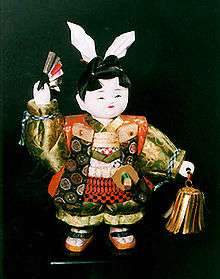
Certain genres of writing originated in and are often associated with Japanese society. These include the haiku, tanka, and I Novel, although modern writers generally avoid these writing styles. Historically, many works have sought to capture or codify traditional Japanese cultural values and aesthetics. Some of the most famous of these include Murasaki Shikibu's The Tale of Genji (1021), about Heian court culture; Miyamoto Musashi's The Book of Five Rings (1645), concerning military strategy; Matsuo Bashō's Oku no Hosomichi (1691), a travelogue; and Jun'ichirō Tanizaki's essay "In Praise of Shadows" (1933), which contrasts Eastern and Western cultures.
Following the opening of Japan to the West in 1854, some works of this style were written in English by natives of Japan; they include Bushido: The Soul of Japan by Nitobe Inazō (1900), concerning samurai ethics, and The Book of Tea by Okakura Kakuzo (1906), which deals with the philosophical implications of the Japanese tea ceremony. Western observers have often attempted to evaluate Japanese society as well, to varying degrees of success; one of the most well-known and controversial works resulting from this is Ruth Benedict's The Chrysanthemum and the Sword (1946).
Twentieth-century Japanese writers recorded changes in Japanese society through their works. Some of the most notable authors included Natsume Sōseki, Jun'ichirō Tanizaki, Osamu Dazai, Yasunari Kawabata, Fumiko Enchi, Yukio Mishima, and Ryōtarō Shiba. In contemporary Japan, popular authors such as Ryū Murakami, Haruki Murakami, and Banana Yoshimoto are highly regarded.
Arts

Decorative arts in Japan date back to prehistoric times. Jōmon pottery includes examples with elaborate ornamentation. In the Yayoi period, artisans produced mirrors, spears, and ceremonial bells known as dōtaku. Later burial mounds, or kofun, preserve characteristic clay haniwa, as well as wall paintings.
Beginning in the Nara period, painting, calligraphy, and sculpture flourished under strong Confucian and Buddhist influences from China. Among the architectural achievements of this period are the Hōryū-ji and the Yakushi-ji, two Buddhist temples in Nara Prefecture. After the cessation of official relations with the Tang dynasty in the ninth century, Japanese art and architecture gradually became less influenced by China. Extravagant art and clothing was commissioned by nobles to decorate their court, and although the aristocracy was quite limited in size and power, many of these pieces are still extant. After the Tōdai-ji was attacked and burned during the Genpei War, a special office of restoration was founded, and the Tōdai-ji became an important artistic center. The leading masters of the time were Unkei and Kaikei.
Painting advanced in the Muromachi period in the form of ink and painting under the influence of Zen Buddhism as practiced by such masters as Sesshū Tōyō. Zen Buddhist tenets were also elaborated into the tea ceremony during the Sengoku period. During the Edo period, the polychrome painting screens of the Kanō school were made influential thanks to their powerful patrons (including the Tokugawas). Popular artists created ukiyo-e, woodblock prints for sale to commoners in the flourishing cities. Pottery such as Imari ware was highly valued as far away as Europe.
In theater, Noh is a traditional, spare dramatic form that developed in tandem with kyōgen farce. In stark contrast to the restrained refinement of noh, kabuki, an "explosion of color", uses every possible stage trick for dramatic effect. Plays include sensational events such as suicides, and many such works were performed in both kabuki and bunraku puppet theaters.
Since the Meiji Restoration, Japan has absorbed elements of Western culture and gave it a "Japanese" feel or modification into it. Its modern decorative, practical and performing arts works span a spectrum ranging from the traditions of Japan to purely Western modes. Products of popular culture, including J-pop, manga and anime have found audiences and fans around the world.
Theories of origins
Arai Hakuseki, who knew in the 18th century that there were stone tools in Japan, suggested that there was Shukushin in ancient Japan. After him, Philipp Franz von Siebold claimed that indigenous Japanese were Ainu people.[44] Iha Fuyū suggested that Japanese and Ryukyuan people have the same ethnic origin, based on his 1906 research of the Ryukyuan languages.[45] In the Taishō period, Torii Ryūzō claimed that Yamato people used Yayoi pottery and Ainu used Jōmon pottery.[44]
A common origin of Japanese has been proposed by a number of scholars since Arai Hakuseki first brought up the theory and Fujii Sadamoto, a pioneer of modern archeology in Japan, also treated the issue in 1781.[46] But after the end of World War II, Kotondo Hasebe and Hisashi Suzuki claimed that the origin of Japanese people was not the newcomers in the Yayoi period (300 BCE – 300 CE) but the people in the Jōmon period.[47]
However, Kazuro Hanihara announced a new racial admixture theory in 1984.[47] Hanihara also announced the theory "dual structure model" in English in 1991.[48] According to Hanihara, modern Japanese lineages began with Jōmon people, who moved into the Japanese archipelago during Paleolithic times from their homeland in southeast Asia. Hanihara believed that there was a second wave of immigrants, from northeast Asia to Japan from the Yayoi period. Following a population expansion in Neolithic times, these newcomers then found their way to the Japanese archipelago sometime during the Yayoi period. As a result, miscegenation was common in the island regions of Kyūshū, Shikoku, and Honshū, but did not prevail in the outlying islands of Okinawa and Hokkaidō, and the Ryukyuan and Ainu people continued to dominate there. Mark J. Hudson claimed that the main ethnic image of Japanese people was biologically and linguistically formed from 400 BCE to 1,200 CE.[47]
Masatoshi Nei opposed the "dual structure model" and alleged that the genetic distance data show that Japanese people originated in northeast Asia, moving to Japan perhaps more than thirty thousand years ago.[49]
On the other hand, research in October 2009 by the National Museum of Nature and Science et al. concluded that the Minatogawa Man, who was found in Okinawa and was regarded as evidence that Jōmon people came to Japan via the southern route, had a slender face unlike the Jōmon.[50] Hiroto Takamiya of the Sapporo University suggested that the people of Kyushu immigrated to Okinawa between the 10th and 12th centuries CE.[51]
A 2011 study by Sean Lee and Toshikazu Hasegawa[52] reported that a common origin of Japonic languages had originated around 2,182 years before present.[53]
Origin of Jōmon and Yayoi
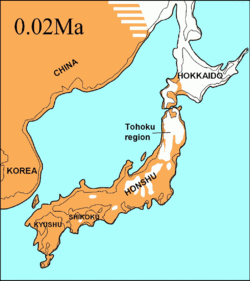
Currently, the most well-regarded theory is that present-day Japanese are descendants of both the indigenous Jōmon people and the immigrant Yayoi people. The origins of the Jōmon and Yayoi people have often been a subject of dispute, and a recent Japanese publisher[54] has divided the potential routes of the people living on the Japanese archipelago as follows:
- Aboriginals that have been living in Japan for more than 10,000 years. (Without geographic distinction, which means, the group of people living in islands from Hokkaido to Okinawa may all be considered to be Aboriginals in this case.)
- Immigrants from the northern route (北方ルート in Japanese) including the people from the Korean Peninsula, Mainland China, Sakhalin Island, Mongolia, and Siberia.
- Immigrants from the southern route (南方ルート in Japanese) including the people from the Pacific Islands, Southeast Asia, and in some context, India.
However, a clear consensus has not been reached.[55][56][57][58][59]
History
Paleolithic era
Archaeological evidence indicates that Stone Age people lived in the Japanese archipelago during the Paleolithic period between 39,000 and 21,000 years ago.[60][61] Japan was then connected to mainland Asia by at least one land bridge, and nomadic hunter-gatherers crossed to Japan from East Asia, Siberia, and possibly Kamchatka. Flint tools and bony implements of this era have been excavated in Japan.[62]
Jōmon people
Some of the world's oldest known pottery pieces were developed by the Jōmon people in the Upper Paleolithic period, 14th millennium BC. The name, "Jōmon" (縄文 Jōmon), which means "cord-impressed pattern", comes from the characteristic markings found on the pottery. The Jōmon people were Mesolithic hunter-gatherers, though at least one middle to late Jōmon site (Minami Mizote (南溝手), ca. 1200–1000 BC) had a primitive rice-growing agriculture. They relied primarily on fish for protein. It is believed that the Jōmon had very likely migrated from North Asia or Central Asia and became the Ainu of today. Research suggests that the Ainu retain a certain degree of uniqueness in their genetic make-up, while having some affinities with other regional populations in Japan as well as the Nivkhs of the Russian Far East.
Mark J. Hudson of Nishikyushu University posits that Japan was settled by a Proto-Mongoloid population in the Pleistocene who became the Jōmon, and that their features can be seen in the Ainu and Ryukyuan people.[63] The Jomon share some physical characteristics, such as relatively abundant body hair, with Caucasians, but anthropological genetics shows them to derive from a separate genetic lineage from that of Europeans.[64]
Anthropologist Joseph Powell of the University of New Mexico said that the Ainu descend from the Jōmon people who are an East Asian population with "closest biological affinity with south-east Asians rather than western Eurasian peoples".[65] Turner found remains of Jōmon people of Japan to belong to Sundadont pattern similar with the Southern Mongoloid living populations of Taiwanese aborigines, Filipinos, Indonesians, Thais, Borneans, Laotians, and Malaysians.
Yayoi people
Around 400–300 BC, the Yayoi people began to enter the Japanese islands, intermingling with the Jōmon. The Yayoi brought wet-rice farming and advanced bronze and iron technology to Japan. Although the islands were already abundant with resources for hunting and dry-rice farming, Yayoi farmers created more productive wet-rice paddy field systems. This allowed the communities to support larger populations and spread over time, in turn becoming the basis for more advanced institutions and heralding the new civilization of the succeeding Kofun period.
The estimated population in the late Jōmon period was about one hundred thousand, compared to about three million by the Nara period. Taking the growth rates of hunting and agricultural societies into account, it is calculated that about one and half million immigrants moved to Japan in the period.
Genetics
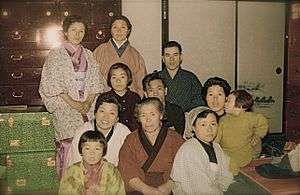
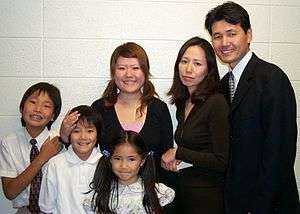
Y-chromosome DNA
It has been noted since as early as 1995 that the distribution of Y-chromosome DNA markers among Japanese males differs significantly from the males of neighboring populations: "The Y Alu polymorphic (YAP) element is present in 42% of the Japanese and absent in the Taiwanese, confirming the irregular distribution of this polymorphism in Asia."[66]
In 1999, a study by Tatiana M. Karafet et al. aimed at identifying the nearest Old World relatives of indigenous American Y-DNA lineages included a sample of 118 Japanese, of whom 55 or 47% were found to belong to DE-YAP(xE-SRY4064), 54 or 46% were found to belong to K-M9(xTat, SRY9138, P-DYS257), 6 or 5.1% were found to belong to C-RPS4Y, 2 or 1.7% were found to belong to P-DYS257, and 1 or 0.8% were found to belong to BT-SRY10831.1(xC-RPS4Y, DE-YAP, K-M9).[67]
A comprehensive study of worldwide Y-DNA diversity (Underhill et al. 2000) included a sample of 23 males from Japan, of whom eight (35%) belonged to haplogroup D-M174 (including one D-M15, one D-M55(xM116.2), five D-M125, and one D-M151), six (26%) belonged to O-M175(xM122, M119, M95), five (22%) belonged to O-M122 (including two O-M122(xM7, M164, M159, M121, M134), two O-M134(xM117/M133), and one O-M117/M133(xM162)), three (13%) belonged to C-M130 (including one C-M130(xM38, M48/M77/M86, M93, M8/M105/M131), one C-M93, and one C-M8/M105/M131), and one (4.3%) belonged to N-M128.[68]
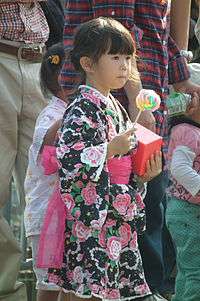
A 2005 study by Michael F. Hammer reports that of the 259 Japanese males samples tested, 34.7% belong to Haplogroup D, O-P31 (31.7%), O-M122 (20.1%), C-M8 (5.4%), C-M217 (3.1%), NO (2.3%) and N (1.5%).[69] The patrilines belonging to D-P37.1 are found in all Japanese groups, but are more frequently found in Ainu (75.0%) and Okinawa (55.6%) and are less frequently found in Shikoku (25.7%) and Kyushu (26.4%).[69] Haplogroup O and C-M8 are not found in Ainu, and C-M217 is not found in Okinawa.[69] Haplogroup N is detected in samples of central Japanese, but is not found in Ainu and Okinawa.[69] This study, and others, report that Y-chromosome patrilines crossed from the Asian mainland into the Japanese archipelago, and continue to make up a large proportion of the Japanese male lineage.[70] If focusing haplogroup O-P31 in those researches, the patrilines derived from its subclade O-SRY465 are frequently found in both Japanese (mean 32%,[71] with frequency in various samples ranging from 26%[72][73] to 36%[74]) and Koreans (mean 30%,[75] with frequency in various samples ranging from 19%[72][76] to 40%[74]). According to the research, these patrilines have undergone extensive genetic admixture with the Jōmon period populations previously established in Japan.[69]
A 2007 study by Nonaka et al. reported among 263 combined samples, the frequencies of the D2, O2b, and O3 lineages were 38.8%, 33.5%, and 16.8%, respectively, which constituted approximately 90% of the Japanese population. Haplogroup diversity for the binary polymorphisms was calculated to be 86.3%.[77]
Poznik et al. (2016) have reported that the males in the JPT (Japanese in Tokyo, Japan) sample[78] of the 1000 Genomes Project are 20/56 = 36% D2-M179, 18/56 = 32% O2b-M176, 10/56 = 18% O3-M122, 4/56 = 7.1% C1a1-M8, 2/56 = 3.6% O2a-K18, and 2/56 = 3.6% C2-M217.[79]
Mitochondrial DNA
According to an analysis of the 1000 Genomes Project's sample of Japanese collected in the Tokyo metropolitan area, the mtDNA haplogroups found among modern Japanese include D (42/118 = 35.6%, including 39/118 = 33.1% D4 and 3/118 = 2.5% D5), B (16/118 = 13.6%, including 11/118 = 9.3% B4 and 5/118 = 4.2% B5), M7 (12/118 = 10.2%), G (12/118 = 10.2%), N9 (10/118 = 8.5%), F (9/118 = 7.6%), A (8/118 = 6.8%), Z (4/118 = 3.4%), M9 (3/118 = 2.5%), and M8 (2/118 = 1.7%).[80]
Single-nucleotide polymorphism
A 2011 SNP consortium study done by the Chinese Academy of Sciences and Max Planck Society consisting of 1719 DNA samples determined that Koreans and Japanese clustered together confirming the findings of an earlier study that Koreans and Japanese are closely related. However, the Japanese were found to be genetically closer to South Asian populations as evident by a genetic position that is significantly closer towards South Asian populations on the principal component analysis (PCA) chart. Some Japanese individuals are also genetically closer to Southeast Asian and Melanesian populations when compared to other East Asians such as Koreans and Han Chinese, indicating possible genetic interactions between Japanese and these populations.[81]
A 2008 study about genome-wide SNPs of East Asians by Chao Tian et al. reported that Japanese, Koreans and Han Chinese are genetically distinguishable from southeast Asians, and that the Japanese are related to Koreans, who are more closely related to Han Chinese. However, the Japanese are relatively genetically distant from Han Chinese, compared to Koreans.[82]
Colonialism
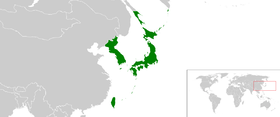
During the Japanese colonial period of 1895 to 1945, the phrase "Japanese people" was used to refer not only to residents of the Japanese archipelago, but also to people from colonies who held Japanese citizenship, such as Taiwanese people and Korean people. The official term used to refer to ethnic Japanese during this period was "inland people" (内地人 naichijin). Such linguistic distinctions facilitated forced assimilation of colonized ethnic identities into a single Imperial Japanese identity.[83]
After the end of World War II, many Nivkh people and Orok people from southern Sakhalin, who held Japanese citizenship in Karafuto Prefecture, were forced to repatriate to Hokkaidō by the Soviet Union as a part of Japanese people. On the other hand, many Sakhalin Koreans who had held Japanese citizenship until the end of the war were left stateless by the Soviet occupation.[84]
Citizenship
Article 10 of the Constitution of Japan defines the term Japanese based on the Japanese Nationality.[85] Indeed, Japan accepts a steady flow of 15,000 new Japanese citizens by naturalization (帰化) per year.[86] The concept of the ethnic groups by the Japanese statistics is different from the ethnicity census of North American or some Western European statistics. For example, the United Kingdom Census asks ethnic or racial background which composites the population of the United Kingdom, regardless of their nationalities.[87] The Japanese Statistics Bureau, however, does not have this question. Since the Japanese population census asks the people's nationality rather than their ethnic background, naturalized Japanese citizens and Japanese nationals with multi-ethnic background are considered to be ethnically Japanese in the population census of Japan. Professor John Lie, from the University of California, Berkeley, in spite of the widespread belief that Japan is ethnically homogeneous, believes it is more accurate to describe Japan as a multiethnic society.[88] Even though such claims have long been rejected by other sectors of Japanese society such as former Japanese Prime Minister Tarō Asō, who has once described Japan as being a nation of "one race, one civilization, one language and one culture".[89]
Diaspora
The term nikkeijin (日系人) is used to refer to Japanese people who emigrated from Japan and their descendants.
Emigration from Japan was recorded as early as the 12th century to the Philippines and Borneo,[90] but did not become a mass phenomenon until the Meiji Era, when Japanese people began to go to the Philippines, United States, Canada, Peru, Colombia, Brazil, and Argentina. There was also significant emigration to the territories of the Empire of Japan during the colonial period; however, most such emigrants repatriated to Japan after the end of World War II in Asia.[91]
According to the Association of Nikkei and Japanese Abroad, there are about 2.5 million nikkeijin living in their adopted countries. The largest of these foreign communities are in the Brazilian states of São Paulo and Paraná.[92] There are also significant cohesive Japanese communities in the Philippines,[93] East Malaysia, Peru, Buenos Aires, Córdoba and Misiones in Argentina, the U.S states of Hawaii, California, and Washington, and the Canadian cities of Vancouver and Toronto. Separately, the number of Japanese citizens living abroad is over one million according to the Ministry of Foreign Affairs.
See also
- Ethnic issues in Japan
- Foreign-born Japanese
- Japantown
- List of Japanese people
- Nihonjinron
- Demographics of Japan
- Ainu people
- Azumi people, an ancient group of peoples who inhabited parts of northern Kyushu
- Burakumin
- Dekasegi
- Ryukyuan people
- Yamato people
- Emishi, a group of people who lived in the northeastern Tōhoku region of Japan.
References
- 1 2 3 "World Factbook: Japan". CIA. Retrieved 15 January 2011.
- ↑ ブラジル連邦共和国 (Federative Republic of Brazil) 基礎データ [Federative Republic of Brazil basic data]. Ministry of Foreign Affairs of Japan (in Japanese). 30 May 2016. Retrieved 30 May 2016.
- ↑ Bianconi, Nara (27 June 2008). "Nipo-brasileiros estão mais presentes no Norte e no Centro-Oeste do Brasil" [Japanese-Brazilians are at their highest presence in the North and Midwest regions of Brazil] (in Portuguese). Japao100.com.br. Retrieved 30 May 2016.
- ↑ American FactFinder - Results
- 1 2 "海外在留邦人数調査統計" [Annual Report of Statistics on Japanese Nationals Overseas] (PDF). Ministry of Foreign Affairs of Japan (in Japanese). October 1, 2010.
- ↑ Agnote, Dario (October 11, 2006). "A glimmer of hope for castoffs". The Japan Times. Archived from the original on June 7, 2011. Retrieved August 9, 2016.
- ↑ Ohno, Shun (2006). "The Intermarried issei and mestizo nisei in the Philippines". In Adachi, Nobuko. Japanese diasporas: Unsung pasts, conflicting presents, and uncertain futures. p. 97. ISBN 978-1-135-98723-7.
- ↑ 2011 National Household Survey: Data tables | Ethnic Origin (264), Single and Multiple Ethnic Origin Responses (3), Generation Status (4), Age Groups (10) and Sex (3) for the ...
- ↑ MOFA: Japan-Peru Relations
- 1 2 3 4 5 6 7 8 9 10 11 12 13 "Annual Report of Statistics on Japanese Nationals Overseas" (PDF). Ministry of Foreign Affairs of Japan. Retrieved 30 May 2016.
- ↑ "Japan-Argentine Relations". Ministry of Foreign Affairs of Japan.
- ↑ "Argentina inicia una nueva etapa en su relación con Japón". Telam.com.ar. Retrieved November 21, 2016.
- ↑ 外務省: 英国(グレートブリテン及び北アイルランド連合王国)基礎データ
- ↑ "Japan-Mexico Relations". Ministry of Foreign Affairs of Japan. Retrieved 12 May 2015.
- ↑ MOFA: Japan-Singapore Relations
- ↑ "Japan-Malaysia Relations (Basic Data)". Ministry of Foreign Affairs, Japan. 7 September 2015. Archived from the original on 25 June 2016. Retrieved 26 June 2016.
- ↑ "Letter from Ambassador of FSM to Japan, Micronesia Registration Advisors, Inc." (PDF). Embassy of the Federated States of Micronesia. 24 February 2006. Retrieved 30 May 2016.
- ↑ ボリビア日系協会連合会(FENABOJA)
- ↑ Tourism New Caledonia | Prepare your trip in New Caledonia
- ↑ "Japan-Paraguay Relations". Ministry of Foreign Affairs of Japan. 24 March 2015. Retrieved 30 May 2016.
- ↑ Pacific Islands President, Bainbridge Lawmakers Find Common Ground » Kitsap Sun
- ↑ 外務省: インド
- ↑ MOFA: Japan-United Arab Emirates Relations
- ↑ "Macau Population Census". Census Bureau of Macau. May 2012. Retrieved 22 July 2016.
- ↑ ウルグアイ東方共和国 (Oriental Republic of Uruguay) 基礎データ [Oriental Republic of Uruguay basic data] (in Japanese). Ministry of Foreign Affairs of Japan. 20 July 2011. Retrieved 30 May 2016.
- ↑ "International Religious Freedom Report 2006". Bureau of Democracy, Human Rights, and Labor. U.S. Department of State. 15 September 2006. Retrieved 4 December 2007.
- ↑ Asia Society - Shinto
- ↑ "Japan - People". Encyclopædia Britannica.
- ↑ "Japan. B. Ethnic Groups". Encarta.
- ↑ "人類学的にはモンゴロイドの一。皮膚は黄色、虹彩は黒褐色、毛髪は黒色で直毛。言語は日本語。" ("日本人". Kōjien. Iwanami.)
- ↑ "人類学上は,旧石器時代あるいは縄文時代以来,現在の北海道〜沖縄諸島(南西諸島)に住んだ集団を祖先にもつ人々。" ("日本人". マイペディア. 平凡社.)
- ↑ "日本民族という意味で、文化を基準に人間を分類したときのグループである。また、文化のなかで言語はとくに重要なので、日本民族は日本語を母語としてもちいる人々とほぼ考えてよい。" ("日本人". エンカルタ. Microsoft.)
- ↑ CIA World Factbook Retrieved on 11 June 2012.
- ↑ United States CIA factbook. Accessed 2007-01-15.
- ↑ The World Factbook
- ↑ Japan
- ↑ Buddhists in the world: Das Who is Who der Buddhisten
- ↑ "Christians use English to reach Japanese youth". Mission Network News. 3 September 2007.
The population of Japan is less than one-percent Christian
- ↑ "Japan, Brazil mark a century of settlement, family ties | The Japan Times Online". 2008-01-15.
- ↑ PANIB – Pastoral Nipo Brasileira
- ↑ "Colonia japonesa en México visita Guadalupe en 54º peregrinación anual". Aciprensa. Retrieved 20 February 2014.
- ↑ "Asian Americans: A Mosaic of Faiths". Pew Research Center's Religion & Public Life Project. July 19, 2012. Retrieved March 17, 2015.
- ↑ "Japanese Americans - Pew Forum on Religion & Public Life". Retrieved March 17, 2015.
- 1 2 Imamura, Keiji (2000). "Archaeological Research of the Jomon Period in the 21st Century". The University Museum, The University of Tokyo. Archived from the original on 2011-09-27. Retrieved December 29, 2010.
- ↑ 伊波普猷の卒論発見 思想骨格 鮮明に (in Japanese). Ryūkyū Shimpō. July 25, 2010. Retrieved March 7, 2011.
- ↑ Roy A. Miller, The Japanese Language. Tokyo: Charles E. Tuttle. 1967, pp. 61-62
- 1 2 3 Nanta, Arnaud (2008). "Physical Anthropology and the Reconstruction of Japanese Identity in Postcolonial Japan". Social Science Japan Journal. Oxford University Press. 11 (1): 29–47. doi:10.1093/ssjj/jyn019. Retrieved January 3, 2011.
- ↑ Hanihara, K (1991). "Dual structure model for the population history of the Japanese". Japan Review. 2: 1–33.
- ↑ Nei, M., In : Brenner, S. and Hanihara, K. (eds.), The Origin and Past of Modern Humans as Viewed from DNA. World Scientific, Singapore, 71-91, 1995
- ↑ Watanabe, Nobuyuki (October 1, 2009). 旧石器時代の「港川1号」、顔ほっそり 縄文人と差. Asahi.com (in Japanese). Asahi Shimbun. Retrieved March 9, 2011.
- ↑ Nakamura, Shunsuke (April 16, 2010). 沖縄人のルーツを探る. Asahi.com (in Japanese). Asahi Shimbun. p. 2. Retrieved March 9, 2011.
- ↑ Hasegawa Laboratory/ College of Arts and Sciences at the University of Tokyo
- ↑ Lee, Sean; Hasegawa, Toshikazu (2011). "Bayesian phylogenetic analysis supports an agricultural origin of Japonic languages". Proceedings of the Royal Society B: Biological Sciences. Royal Society. 278: 3662–3669. doi:10.1098/rspb.2011.0518. Retrieved May 6, 2011.
- ↑ from the book, 2009, Japanese published by Heidansha. "日本人". マイペディア. 平凡社. Original sentence:旧石器時代または縄文時代以来、現在の北海道から琉球諸島までの地域に住んだ集団を祖先に持つ。シベリア、樺太、朝鮮半島などを経由する北方ルート、南西諸島などを経由する南方ルートなど複数の渡来経路が考えられる
- ↑ Three major lineages of Asian Y chromosomes: impli... [Hum Genet. 2002] - PubMed - NCBI
- ↑ Archived December 17, 2005, at the Wayback Machine.
- ↑ Archived August 24, 2005, at the Wayback Machine.
- ↑ NOVA Online | Lost Tribes of Israel | Where are the Ten Lost Tribes? (3)
- ↑ Archived June 25, 2006, at the Wayback Machine.
- ↑ Global archaeological evidence for proboscidean overkill in PNAS online; Page 3 (page No.6233), Table 1. The known global sample of proboscidean kill/scavenge sites :Lake Nojiri Japan 33-39 ka (ka: thousand years).
- ↑ "Prehistoric Times". Web Site Shinshu. Nagano Prefecture. Retrieved January 22, 2011.
- ↑ Lake Nojiri Museum, Lake Nojiri Excavation and Research Team (in Japanese); many flint tools and bony implements were found with the same age of Naumann Elephant in Lake Nojiri.
- ↑ Hudson, M.J. (1999) Ruins of Identity: Ethnogenesis in the Japanese Islands. Honolulu: University of Hawai`i Press
- ↑ Koppel, Tom (2005) Lost World: Rewriting Prehistory — How New Science Is Tracing America's Ice Age Mariners. New York: Atria Books. Madsen. ISBN 0-7434-5357-3
- ↑ Powell, Joseph F.; Rose, Jerome C. Chapter 2 Report on the Osteological Assessment of the Kennewick Man Skeleton (CENWW.97.Kennewick). Retrieved September 10, 2011.
- ↑ Michael F. Hammer and Satoshi Horai, "Y Chromosomal DNA Variation and the Peopling of Japan." American Journal of Human Genetics 56:951-962, 1995. Received September 22, 1994; accepted for publication January 19, 1995.
- ↑ T. M. Karafet, S. L. Zegura, O. Posukh, et al., "Ancestral Asian Source(s) of New World Y-Chromosome Founder Haplotypes." American Journal of Human Genetics 64:817–831, 1999. Received July 16, 1998; accepted for publication January 13, 1999; electronically published February 19, 1999.
- ↑ Peter A. Underhill, Peidong Shen, Alice A. Lin, et al., "Y chromosome sequence variation and the history of human populations." Nature Genetics, Volume 26, November 2000.
- 1 2 3 4 5 Hammer, Michael F. (2005). "Dual origins of the Japanese: common ground for hunter-gatherer and farmer Y chromosomes". The Japan Society of Human Genetics and Springer-Verlag. Springer Science+Business Media via Max Planck Institute for Evolutionary Anthropology. 51 (1): 47–58. doi:10.1007/s10038-005-0322-0. PMID 16328082. Archived from the original (PDF) on 2007-07-28. Retrieved January 19, 2007.
- ↑ Travis, John (February 15, 1997). "Jomon genes: using DNA, researchers probe the genetic origins of modern Japanese - Cover Story". Science News. BNET. Retrieved January 22, 2011.
- ↑ 238/744 = 32.0% O2b-SRY465 in a pool of all Japanese samples of Xue et al. (2006), Katoh et al. (2004), Han-Jun Jin et al. (2009), Nonaka et al. (2007), and all non-Ainu and non-Okinawan Japanese samples of Hammer et al. (2006).
- 1 2 Han-Jun Jin; Kyoung-Don Kwak; Michael F. Hammer; Yutaka Nakahori; Toshikatsu Shinka; Ju-Won Lee; Feng Jin; Xuming Jia; Chris Tyler-Smith; Wook Kim (2003). "Y-chromosomal DNA haplogroups and their implications for the dual origins of the Koreans". Human Genetics.
- ↑ Jin, Han-Jun; Tyler-Smith, Chris; Kim, Wook (2009). "The Peopling of Korea Revealed by Analyses of Mitochondrial DNA and Y-Chromosomal Markers". PLoS ONE. 4 (1): e4210. doi:10.1371/journal.pone.0004210. PMC 2615218
 . PMID 19148289.
. PMID 19148289. 
- 1 2 Katoh, Toru; Munkhbat, Batmunkh; Tounai, Kenichi; Mano, Shuhei; Ando, Harue; Oyungerel, Ganjuur; Chae, Gue-Tae; Han, Huun; Jia, Guan-Jun; Tokunaga, Katsushi; Munkhtuvshin, Namid; Tamiya, Gen; Inoko, Hidetoshi (2004). "Genetic features of Mongolian ethnic groups revealed by Y-chromosomal analysis". Gene. 346: 63–70. doi:10.1016/j.gene.2004.10.023. PMID 15716011.
- ↑ 202/677 = 29.8% O2b-SRY465 in a pool of all ethnic Korean samples of Hammer et al. (2006), Xue et al. (2006), Katoh et al. (2004), Wook Kim et al. (2007), and Han-Jun Jin et al. (2009).
- ↑ Kim, Wook; Yoo, Tag-Keun; Kim, Sung-Joo; Shin, Dong-Jik; Tyler-Smith, Chris; Jin, Han-Jun; Kwak, Kyoung-Don; Kim, Eun-Tak; Bae, Yoon-Sun (January 24, 2007). "Lack of Association between Y-Chromosomal Haplogroups and Prostate Cancer in the Korean Population". PLoS ONE. 2 (1): e172. doi:10.1371/journal.pone.0000172. PMC 1766463
 . PMID 17245448.
. PMID 17245448. 
- ↑ Nonaka, I.; Minaguchi, K.; Takezaki, N. (February 2, 2007). "Y-chromosomal Binary Haplogroups in the Japanese Population and their Relationship to 16 Y-STR Polymorphisms". Annals of Human Genetics. John Wiley & Sons. 71 (Pt 4): 480–95. doi:10.1111/j.1469-1809.2006.00343.x. PMID 17274803.
- ↑ The JPT sample is considered "as generally representative of the majority population in Japan". See Matsuda, Ichiro. "Japanese in Tokyo, Japan - Population Description". Camden, NJ: Coriell Institute for Medical Research.
- ↑ G. David Poznik, Yali Xue, Fernando L. Mendez, et al., "Punctuated bursts in human male demography inferred from 1,244 worldwide Y-chromosome sequences." Nature Genetics (2016) doi:10.1038/ng.3559.
- ↑ Zheng H-X, Yan S, Qin Z-D, Wang Y, Tan J-Z, et al. 2011 Major Population Expansion of East Asians Began before Neolithic Time: Evidence of mtDNA Genomes. PLoS ONE 6(10): e25835. doi:10.1371/journal.pone.0025835
- ↑ "Identification of Close Relatives in the HUGO Pan-Asian SNP Database". Plos One. 29 December 2011. Retrieved 30 May 2016.
- ↑ Tian, Chao; Kosoy, Roman; Lee, Annette; Ransom, Michael; Belmont, John W.; Gregersen, Peter K.; Seldin, Michael F. (December 5, 2008). "Analysis of East Asia Genetic Substructure Using Genome-Wide SNP Arrays". PLoS ONE. Public Library of Science. 3 (12): e3862. doi:10.1371/journal.pone.0003862. PMC 2587696
 . PMID 19057645. Retrieved May 7, 2011.
. PMID 19057645. Retrieved May 7, 2011. - ↑ Eika Tai (September 2004). "Korean Japanese". Critical Asian Studies. Routledge. 36 (3): 355–382. doi:10.1080/1467271042000241586.
- ↑ Lankov, Andrei (January 5, 2006). "Stateless in Sakhalin". The Korea Times. Archived from the original on 2006-02-21. Retrieved November 26, 2006.
- ↑ [日本国憲法]
- ↑ 帰化許可申請者数等の推移
- ↑ "United Kingdom population by ethnic group". United Kingdom Census 2001. Office for National Statistics. 2001-04-01. Archived from the original on January 7, 2010. Retrieved 2009-09-10.
- ↑ John Lie Multiethnic Japan (Cambridge, Mass.: Harvard University Press, 2001)
- ↑ "Aso says Japan is nation of 'one race'". The Japan Times. October 18, 2005.
- ↑ Philippines History, Culture, Civilization and Technology, Filipino
- ↑ Lankov, Andrei (March 23, 2006). "The Dawn of Modern Korea (360): Settling Down". The Korea Times. Archived from the original on 2006-06-19. Retrieved December 18, 2006.
- ↑ IBGE. Resistência e Integração: 100 anos de Imigração Japonesa no Brasil apud Made in Japan. IBGE Traça o Perfil dos Imigrantes; 21 de junho de 2008 Accessed September 4, 2008. (Portuguese)
- ↑ Furia, Reiko (1993). "The Japanese Community Abroad: The Case of Prewar Davao in the Philippines". In Saya Shiraishi; Takashi Shiraishi. The Japanese in Colonial Southeast Asia. Southeast Asia Program, Cornell University Publications. p. 157. ISBN 978-0-87727-402-5. Retrieved 30 May 2016.
External links
 Media related to People of Japan at Wikimedia Commons
Media related to People of Japan at Wikimedia Commons- C3-M217, FTDNA [DNA project]
- CIA The World Fact Book 2006
- The Association of Nikkei & Japanese Abroad
- Discover Nikkei- Information on Japanese emigrants and their descendants
- Jun-Nissei Literature and Culture in Brazil
- The Ministry of Foreign Affairs of Japan
- The National Museum of Japanese History
- Japanese society and culture
- Dekasegi and their issues living in Japan (Portuguese) (Japanese)
